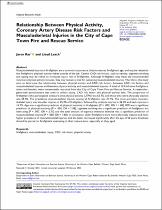| dc.identifier.citation | Ras, J., & Leach, L. (2022). Relationship between physical activity, coronary artery disease risk factors and musculoskeletal injuries in the City of Cape Town fire and rescue service. INQUIRY: The Journal of Health Care Organization, Provision, and Financing, 59, 1–13. https://doi.org/10.1177/00469580221084485 | en_US |
| dc.description.abstract | Musculoskeletal injuries in firefighters are a common occurrence, that increase as firefighters age, and may be related to
the firefighters’ physical activity habits outside of the job. Certain CAD risk factors, such as obesity, cigarette smoking
and ageing may be linked to increased injury risk in firefighters. Although firefighters may meet the recommended
minimum physical activity minutes, they may remain at risk for sustaining musculoskeletal injuries. Therefore, this study
aims to determine the relationship between physical activity and CAD risk factors, between CAD risk factors and
musculoskeletal injuries and between physical activity and musculoskeletal injuries. A total of 124 full-time firefighters,
males and females, were conveniently recruited from the City of Cape Town Fire and Rescue Service. A researchergenerated questionnaire was used to collect injury, CAD risk factor and physical activity data. The proportion of
firefighters who participated in leisure-time physical activity (LTPA) was 63.7%, and those who were physically inactive
was 69.4%. The prevalence musculoskeletal injuries among all firefighters was 27.4%. The most prevalent musculoskeletal injury was shoulder injuries in 35.3% of firefighters, followed by multiple injuries in 26.5% and back injuries in
14.7%. Age was a significant predictor of physical inactivity in firefighters [P = .002, OR = 1.08], BMI was a significant
predictor of physical inactivity [P = .050, OR = 1.08], cigarette smoking was a significant predictor of firefighters not
exercising [P = .007, OR = 2.31] and the total amount of vigorous-intensity exercise was a significant predictor of
musculoskeletal injuries [P = .050, OR = 1.00]. In conclusion, older firefighters were more physically inactive and had a
higher prevalence of musculoskeletal injuries, and the latter decreased significantly after the age of 50 years. Emphasis
should be placed on firefighters exercising in their leisure-time, especially as they aged. | en_US |

